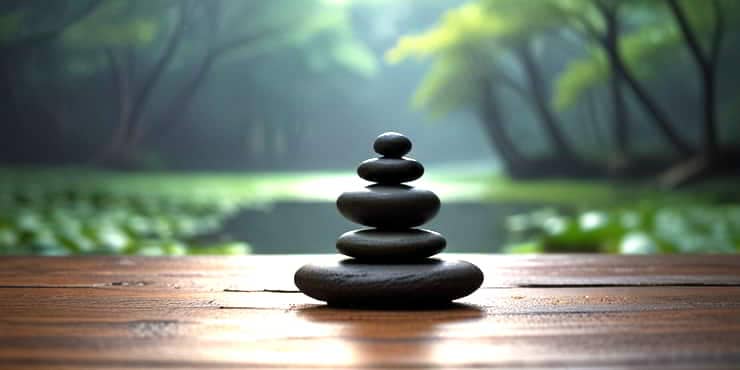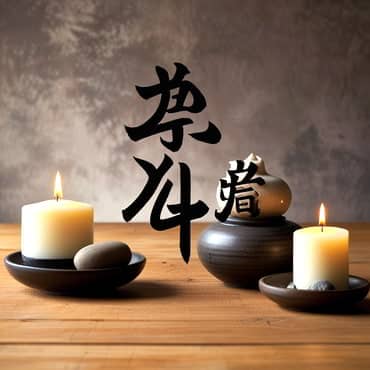Finding Your Zen: Simple Techniques for Everyday Mindfulness

Estimated reading time: 8 Min
In modern life, finding a moment of peace can be like searching for a needle in a haystack. It is possible with simple techniques of everyday mindfulness.
The word Zen, a Japanese word based on the Chinese “cha’an,” is refers to the idea of enlightenment or awareness.
The concept of Zen, with its roots in mindfulness practices, offers a beacon of hope.
Perhaps you have already wondered if mindfulness could be your secret weapon against the chaos of everyday life?
Imagine turning the mundane into moments of tranquillity, transforming stress into calm.
Let me share a story that might sound familiar.
On a day overwhelmed by back-to-back meetings and relentless email notifications, the idea of peace seems far-fetched.
But it was during one such day that I discovered the power of mindfulness.
Having read an article the evening before, just five minutes of intentional, focused, deep breaths brought an unexpected calmness—a moment of Zen that changed everything.
Following instructions, I focused on my diaphragm rising and falling, the sound of the air in and out, and the temperature difference between the air going in through my nose and out through my mouth.
Priorities that had been conflicting became instantly clearer.
This revelation led me down the path of exploring mindfulness further, a journey I now invite you to join.
The Essence of Everyday Mindfulness
At its core, mindfulness is about being fully present, engaging completely with the now, without judgement or distraction.
Mindfulness is like having a spotlight of the mind, illuminating the present moment and offering focus where there was none before.
Studies have shown that regular mindfulness practice can also significantly improve both mental and physical health, reducing symptoms of anxiety, depression, and even chronic pain.
But its benefits extend beyond health; mindfulness can enhance our relationships, creativity, and overall quality of life, casting a wide net of positivity over the choppy waters of our daily existence.
Debunking Mindfulness Myths

When Zen, or mindfulness, is mentioned, images of serene monks meditating for hours in distant, tranquil monasteries might spring to mind.
However, mindfulness is not exclusive to monks or the spiritually enlightened; it’s accessible to everyone, monk or not, in the chaos of city life or the quiet of the countryside.
One common myth is that mindfulness requires perfect silence and hours of meditation.
This is not so.
Mindfulness can be as simple as taking a minute to notice the sensation of your feet touching the ground as you walk or the taste of your food as you eat.
It’s about finding Zen in the ordinary, transforming routine activities into rituals of awareness.
So, even if the closest you’ve come to meditation is contemplating your coffee in the morning, you’re more prepared for mindfulness than you might think.
Mindfulness in Action: Incorporating Zen into Your Daily Routine
Incorporating mindfulness into your daily routine doesn’t require drastic changes to your lifestyle; rather, it’s about weaving moments of awareness into the fabric of your day.
- Mindful breathing
Consider this the reset button for your brain. In moments of stress or overwhelm, take a minute to focus solely on your breath. Picture it as clearing your mind’s browser cache, making space for fresh thoughts and perspectives. - Mindful eating
Next time you eat, do it mindfully. Savour each bite as if you’re tasting your favourite dish for the first time. Notice the texture, the flavours, and the temperature. It’s about reconnecting with the experience of eating, beyond just the act of fueling your body. - Mindful walking
Transform your daily walks into exercises of mindfulness. Observe the sensation of your feet making contact with the ground, the rhythm of your stride, and the sounds around you. It’s like discovering a previously unnoticed path in a familiar forest, offering new insights and wonders with each step.
These simple practices serve as gateways to a more mindful existence, transforming ordinary moments into extraordinary opportunities for presence and peace.
Mindfulness and Technology: Navigating the Digital World
In today’s technological age, our screens often become extensions of our minds, cluttered with the endless noise of notifications and news feeds.
Yet, mindfulness offers a way to navigate this digital world without getting lost in it.
Think of technology as a tool, not a tyrant.
Here are some strategies for mindful use of technology:
- Digital detoxes
Schedule regular intervals where you disconnect from digital devices. This isn’t about shunning technology but rather taking intentional breaks to reconnect with the physical world. - Mindful notifications
Curate your notifications so that only the essential ones break through your day. It’s like being selective about who you invite into your mental living room. - Conscious consumption
Approach online content with intentionality, asking whether what you’re consuming adds value to your life or simply fills it with digital clutter.
Overcoming Challenges on the Path to Mindfulness
As with any new habit, the path to mindfulness is not without its obstacles.
Wandering thoughts, impatience, and discouragement can all emerge as formidable foes. Here’s how to navigate these challenges:
- Embrace wandering thoughts
Realise that mind wandering is natural. Each time you notice your thoughts drifting, gently guide them back. It’s not a failure but a part of the process, like a musician gently correcting a note. - Start small
If sitting still for meditation seems daunting, start with one-minute mindfulness exercises. Gradually increase the time as your comfort grows. Rome wasn’t built in a day, and neither is a mindfulness practice. - Find a community
Sharing your journey with others can provide encouragement, tips, and a sense of belonging. Whether it’s a local meditation group or an online forum, community can be a powerful catalyst for growth.
Building a Personal Zen Space

Creating a physical or mental space for mindfulness can significantly enhance your practice.
This doesn’t require a complete home makeover; rather, it’s about setting aside a corner that invites calm and focus.
- Physical space
Choose a corner of your home where you can sit quietly, free from distractions. Populate it with objects that inspire tranquility—perhaps a plant, a simple piece of art, or a candle.
This space should be a visual and emotional cue to shift into mindfulness mode. - Mental space
Develop a mental imagery practice, envisioning a place where you feel utterly at peace. This could be a real location or a composite of places that calm you. Visiting this mental Zen space can be a quick way to centre yourself, especially when physical solitude is not possible.
FAQs
1. How long does it take to see benefits from practicing mindfulness?
While some individuals notice changes in their stress levels and overall mood immediately, the full benefits of mindfulness often emerge over weeks, months, and years of consistent practice. Think of it as a journey rather than a quick fix, with gradual improvements in well-being, focus, and emotional regulation.
2. Is it normal for my mind to wander during mindfulness exercises?
Absolutely. Mind-wandering is a natural aspect of the human mind. The practice of mindfulness is not to prevent this but to notice when it happens and gently redirect your focus back to the present moment. This awareness and redirection are at the heart of mindfulness practice.
3. Can mindfulness help with anxiety?
Yes, numerous studies have shown that mindfulness can significantly reduce symptoms of anxiety. By fostering an awareness of the present moment and reducing tendencies to ruminate on past or future worries, mindfulness can help manage anxious thoughts.
4. Do I need to meditate to practice mindfulness?
While meditation can be a powerful tool for cultivating mindfulness, it’s not the only way. Mindfulness can be practiced through everyday activities like eating, walking, or even washing dishes. The key is to be fully present and engaged with whatever it is that you’re doing.
5. How can I incorporate mindfulness into my busy schedule?
Start with small, manageable practices. Even just a few minutes of mindful breathing or paying full attention to the first bites of a meal can be effective. Look for moments throughout your day that can be opportunities for mindfulness, turning routine tasks into mindful rituals.
Summary: The Journey Continues
As with most outcomes in life, embracing mindfulness is not about reaching a destination but about journeying towards a more present, peaceful existence.
It’s a lifestyle choice and a path marked by continuous discovery, where each moment offers a new opportunity for awareness.
Realise that the essence of mindfulness lies in its simplicity and accessibility; it’s about finding Zen in the ordinary, transforming everyday experiences into profound moments of connection and peace.
As you integrate these practices into your life, reflect on the changes you observe.
Mindfulness, much like a garden, flourishes with regular care and attention.
And just as no two gardens are the same, your mindfulness practice is uniquely yours, a personal sanctuary of peace in the bustling world.
I invite you to share your mindfulness journey in the comments below.
What techniques have you found most effective?
How has mindfulness transformed your daily routine?
By sharing our stories, we inspire and uplift each other, cultivating a community of mindful living.
Through mindfulness, we discover that Zen is not found in distant mountaintops or ancient texts but within ourselves, in the everyday moments waiting to be uncovered.
Let’s continue this journey together, embracing each moment with presence, kindness, and curiosity.
In the meantime, please add any comments or questions.
😉
Richard
Additional Resources
To further explore the transformative power of mindfulness and expand your practice, consider delving into these resources:
- Books:
- “Wherever You Go, There You Are” by Jon Kabat-Zinn is a foundational read that introduces mindfulness practice to everyday life, emphasising simplicity and presence.
- “The Miracle of Mindfulness” by Thich Nhat Hanh offers practical exercises and insights to cultivate mindfulness, penned by one of the most revered Zen masters of our time.
- Apps:
- Headspace: Offers guided meditations for a range of goals, from stress reduction to better sleep.
- Calm: features a wide array of mindfulness exercises, including guided meditations, sleep stories, and breathing exercises.
- Websites:
- Mindful.org: is a comprehensive resource for mindfulness news, articles, and guided practices.
- The Mindfulness Project: Offers courses, workshops, and a blog to support mindfulness practice.
- Podcasts:
- “The Daily Meditation Podcast“: Provides daily guided meditations to help listeners find more peace and clarity in their lives.
- “On Being with Krista Tippett“: Explores deep questions of meaning, faith, ethics, and what it means to be human, often touching on mindfulness themes.
These resources aim to support and enrich your mindfulness journey, offering opportunities for exploration and addressing common concerns. Whether you’re just beginning or seeking to deepen your practice, remember that mindfulness is a personal journey, unique to each individual’s experience and lifestyle.






